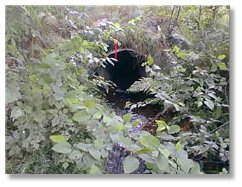| The $100 000
Culvert?
As we prepare for phase 2 of the Haig-Brown Kingfisher Creek restoration project, it
might be worth looking at what kind of restoration efforts have been made in the Haig-Brown
Kingfisher Creek watershed in the past.
Since the project's conception by Roderick Haig-Brown in the 1970's, a key aim of
the project has been to re-route the main stream channels out of culverts and along a more
natural course through the Haig-Brown property. This diversion would provide both access and
habitat for the salmon of Haig-Brown Kingfisher Creek. However, plagued with financial and
planning problems, diverting the creek to its new course has required extensive negotiations with
agencies such as the BC Highways Branch and the District of Campbell River.
One of the problems faced during the first Phase of the project in the early 1980's
was finding a way to put in the final culvert that would take the new creek across the highway to
join the river. The culvert had to provide the creek waters with enough gradient to flow to the
Campbell River.

Downstream from Culvert
Three existing water lines that had been installed along Campbell River Road (Hwy 28)
presented a significant obstruction to the installation of the culvert. All three utility lines had
been installed at different depths, making it difficult to install a new culvert either above or
below the lines.
|
Adding to the problem was the proposed cost of constructing a culvert, which was originally
priced at $100,000. This price was far to steep to be met by the Haig-Brown Kingfisher Creek
Society at the time.

$100,000 Culvert
Finally in 1984, due to the immediate need to expand the existing water lines anyway
(as a result of population growth), the Ministry of Highways agreed to put in the needed culvert.
This allowed the scheduling of the official start of the diversion of the Kingfisher Creek out
of culverts and across Haig-Brown property . Soon, the new creek channel was excavated on the
Haig-Brown property, vegetation was planted, and the new culvert was installed. Only runoff
was allowed to flow through the channel until the planted vegetation was established.
Today, 15-meter alder trees and a variety of established shrub species stand on the
banks of the diverted reach of the creek. Coho fry may be spotted while walking down the
Kingdom Come trail along the new segment of Haig-Brown Kingfisher Creek. This thriving new
reach of the creek is a great example of the success of community-based habitat restoration
projects. Similar restoration will be carried on upstream, as well as on similar creeks around the
country.
Top of page.
|



